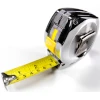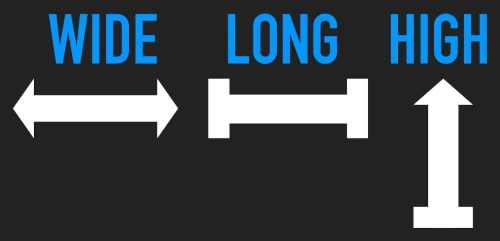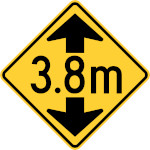 How Wide? How Long? How High? These questions, when asked in relation to vehicles and their loads, probably bring large commercial vehicles to mind for most drivers. However, the rules on the maximum allowable sizes apply to light non-commercial vehicles as well.
How Wide? How Long? How High? These questions, when asked in relation to vehicles and their loads, probably bring large commercial vehicles to mind for most drivers. However, the rules on the maximum allowable sizes apply to light non-commercial vehicles as well.

How High
4.15m (13' 7") is the maximum height allowed. Beware of clearance signs as you approach overhead structures because loads that are of legal height may be too high to pass underneath.

This has become enough of a problem that Commercial Vehicle Safety and Enforcement (CVSE) as started to report bridge strike incidents to the public.
How Long
12.5m (41' 4") is the maximum length allowed for a single vehicle, with the exception of a bus, motorhome or recreation vehicle. Those vehicles may be up to 14.65m (48') long.
Front and Rear Overhang
A vehicle's load must not project more than 1m (3' 3") ahead of the front bumper, 1.85m (6') behind the back of the vehicle or 4.5m (14' 9") behind the center of the last axle.
How Wide
2.6m (8' 6") is the maximum width allowed.
Regardless of this limit, the load is not allowed to be wider than the sides of the vehicle carrying it.
Exemptions
Commercial vehicles may obtain exemptions from basic size rules through the use of a special exemption permit as long as the conditions of the permit are followed. The regulations do provide for the use of permits for light vehicles as well, but the last time I checked with CVSE the policy was that these permits would not be issued.
Where to Get Help
The advice in this article covers basic vehicle sizes most likely to be encountered by light vehicle drivers.
Things can get quite complicated from here if you add a trailer, are driving a pickup truck or delivery van or are carrying special commodities.
Perhaps the simplest way to get advice before you set out on your trip is to know your exact dimensions and contact the nearest weigh scale. The inspectors there will provide expert advice and some scales are always open for your call.
Share This Article
My question would be these pick-up trucks that have sled decks mounted on them, these stick out out past most mirrors which I guess then they would be to wide wouldn't they?
- Log in to post comments
I'm wondering about this, particularly in regard to vehicle length:
In general, your vehicle and it's load cannot be more than 2.6 m (8' 6") wide, 12.5 m (41') long and 4.15 m (13' 7") high.
Seems to me that the majority of semi-trailers we see on the roads these days are 53' long (not even including the tractor unit).
So, I'm puzzled.
- Log in to post comments
For those of us in cars and pickups, it's probably a more or less valid expression.
- Log in to post comments
Wonder if this showed up in the recent posts due to the above accident.
Back when I got my drivers licence it had to be taken on a vehicle under 2725Kg (6,000 Lbs). If you were driving anything with a higher GVW you had to get your "C" licence which would be comparable to a Class 3 today. If you got your licence on a automatic you were restricted to driving automatics. May seem like a minor detail but as I like to explain it you can take your licence on a Honda Civic automatic today and walk across the street and rent a 5 ton truck with a standard transmission and 2 speed axle. Completely legal and then we wonder why we have problems on our highways. Not sure how this works out with the Graduated licence system.
As for the recent accident on the Sea to Sky I do see a few infractions but then one is speculating on what you can see in the picture. What actual happened can be completely different. One thing you cannot argue is the load was not properly secured.
How the regulations of the 1950's play into this is the knowledge required to get that higher licence. I got my licence for driving a car on Monday and upgraded to the equivalent of Class 1 with air on Wednesday. Regulations were far lighter in those days but you still had to know your maximum width, height, length, allowable overhang etc. I have taken several practice test over the years and courses on defensive driving etc. yet have never seen any questions on properly securing a load or how far you can have a overhang past your rear lights.
Recently on another theme I questioned bike racks. I'm positive that some of those exceed the maximum and most obscure the licence plate. All infractions. Unfortunately the people that should be enforcing the MVA in this province have blinkers on and can only see a couple of things. If your speeding, don't have a seatbelt, using you cell phone. Until the MVA is enforced we are going to continue to see accidents like the above. And the vast majority of the public is happy with this. I'll probably get flack for defending speeders. In this weeks article the topic is immediate road side suspensions. Most people are happy with letting cops be Judge and Jury on someone that blows 0.5 impounding their vehicle and causing them thousands of dollars in fines. Yet accidents such as the one on the Sea to Sky happen because no one cares if a load is improperly secured, over hangs any of the vehicle too far, a bike rack sticks out too far, conceals the licence plate and in some cases signal lights.
I have watched vehicles go through road checks with ticketable infractions with nothing being said or done. As long as you are not in violation of what is being checked that day you are fine to carry on your merry way.
- Log in to post comments
I'm wondering how wide a roofrack on a passanger car/suv can be?
In the original post DriveSmartBC stated:
If you are driving something other than a pickup or delivery van, the load cannot be wider than the sides of the vehicle.
On the other hand in the Motor Vehicle Act Regulations it is stated:
Provisions of Commercial Transport Regulations adopted
19.02 (3) Notwithstanding any other provision of this Division, no person shall, without a permit issued pursuant to section 19.06, drive or operate on a highway
(e) a vehicle so loaded that any part of the load extends beyond the sides of the vehicle.
So I'm struggling with the interpretation of all this... does the "sides of the vehicle" include the span of the wing mirrors or just the footprint of the car at a particular point? I see pickups with sled beds and truck bed campers clearly protruding beyond the footprint of the vehicle (as mentioned in one of the previous posts) so I guess wing-mirror-to-wing-mirror is ok? Also with hitch-mounted bike racks I often see the bigger bikes protruding past the car sides. The 'within the mirrors' interpretatin is also suggested by some Canadian retailers e.g. here. However the original post, in the quote I pasted, seems to imply pickups and delivery vans are somehow special - is that so and why?
My roofrack is wider than the body of my suv at the point it is mounted, but within the width of the mirrors - which is quite practical for e.g. shlepping two kayaks side-by-side up there or ski-clamp + rooftop box, and I don't see how it would do anybody any harm - especially that the pickups with wide sled beds are happily allowed...
-Thanks for your help!
- Log in to post comments
Perhaps the easiest way to tell if your vehicle qualifies to be called commercial or not is to look at the licence plate. Back before the new LLN-NNL combination, passenger plates were either LLL-NNN or NNN-LLL. Commercial vehicles were NNNNLL. Otherwise, refer to your registration document. Commercial vehicles are registered under the Commercial Transport Act.
When it comes to size for non-commercial vehicles (mirrors are not included in vehicle width) the MVAR says, as you point out, we incorporate the commercial vehicle rules. However, overwidth is not permitted unless you have a permit and CVSE says that they will not grant them.
So, your roof rack cannot be wider than the sides of your car.
When you talk about pickup trucks, you are now talking about a commercial vehicle and different rules apply.
- Log in to post comments
Thanks a lot for a prompt response - much appreciated!
My vehicle is not registered as a commercial vehicle - and I strongly suspect neither are the pickups with double width (and definitely overhanging) sled beds.
Regarding this statement regarding mirrors not being counted towards the vehicle width:
for non-commercial vehicles (mirrors are not included in vehicle width)
Do you have any basis for this statement in any of the regulations?
Are all pickups registered as commercial vehicles in BC? - Frankly that seems improbable given the types of vehicles loaded up with double width sled platforms zooming up and down Sea-to-Sky every winter and old jalopies sporting overhanging slide-in campers around Squamish and even Spanish Banks...
- Log in to post comments
"commercial vehicle" includes
(a) a motor vehicle having permanently attached to it a truck or delivery body,
Vehicle width
7.06 A person must not, without a permit, drive or operate on a highway a vehicle having a total outside width in excess of 2.6 m, but not including the following as part of that width:
(b) one or more mirrors, fitted for the purpose of conforming to the requirements of the Motor Vehicle Act Regulations, which do not extend more than 30 cm on each side beyond the total width of vehicle and load otherwise permitted by this section;
- Log in to post comments
- Log in to post comments

How wide,how long, how high